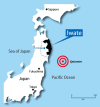Population-based incidence of sudden cardiac and unexpected death before and after the 2011 earthquake and tsunami in Iwate, northeast Japan
- PMID: 24811614
- PMCID: PMC4309070
- DOI: 10.1161/JAHA.114.000798
Population-based incidence of sudden cardiac and unexpected death before and after the 2011 earthquake and tsunami in Iwate, northeast Japan
Abstract
Background: The aim of this study was to evaluate the temporal impact of the 2011 Japan earthquake and tsunami on the incidence of sudden cardiac and unexpected death (SCUD).
Methods and results: We surveyed the impact of the disaster on the incidence and clinical characteristics of SCUD in Iwate. To perform complete identification of SCUD for 8 weeks before and 40 weeks after the disaster, medical records and death certificates relevant to SCUD were surveyed in the study area. Compared with the previous year's rate, the incidence (per 10 000 person-year) of SCUD for the initial 4 weeks after the disaster (acute phase) was double (33.5 vs 18.9), and thereafter the rate returned to the previous level. Significant relationships were found between weekly numbers of SCUD and seismic activity (intensity, r=0.43; P<0.005: frequency, r=0.46; P<0.002). The standardized incidence ratio (SIR) of SCUD in the acute phase was significantly increased compared with that of previous years (1.71, 95% CI 1.33 to 2.16). Increased SIRs were predominantly found in female subjects (1.73, 95% CI 1.22 to 2.37), the elderly (1.73, 95% CI 1.29 to 2.27), and residents living in the tsunami-stricken area (1.83, 95% CI 1.33 to 2.46). In addition, SIRs for weekdays (1.71, 95% CI 1.28 to 2.24) and nights-mornings (2.09, 95% CI 1.48 to 2.86) were amplified.
Conclusions: The present results suggest that the magnitude of a disaster, related stress, and population aging may cause a temporary increase in the incidence of SCUD with amplification of ordinary weekly and circadian variations.
Keywords: disaster; general population; incidence; sudden death.
Figures




References
-
- Trichopoulos D, Katsouyanni K, Zavitsanos X, Tzonou A, Dalla‐Vorgia P. Psychological stress and fatal heart attack: the Athens (1981) earthquake natural experiment. Lancet. 1983; 1:441-444. - PubMed
-
- Leor J, Kloner RA. The Northridge earthquake as a trigger for acute myocardial infarction. Am J Cardiol. 1996; 77:1230-1232. - PubMed
-
- Kloner RA, Leor J, Poole WK, Perritt R. Population‐based analysis of the effect of the Northridge Earthquake on cardiac death in Los Angeles county, California. J Am Coll Cardiol. 1997; 30:1174-1180. - PubMed
-
- Suzuki S, Sakamoto S, Koide M, Fujita H, Sakuramoto H, Kuroda T, Kintaka T, Matsuo T. Hanshin‐Awaji earthquake as a trigger for acute myocardial infarction. Am Heart J. 1997; 134:974-977. - PubMed
-
- Kario K, Ohashi T. Increased coronary heart disease mortality after the Hanshin‐Awaji earthquake among the older community on Awaji Island. Tsuna Medical Association. J Am Geriatr Soc. 1997; 45:610-613. - PubMed
Publication types
MeSH terms
LinkOut - more resources
Full Text Sources
Other Literature Sources
Medical

